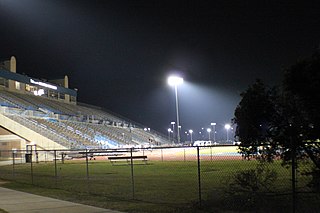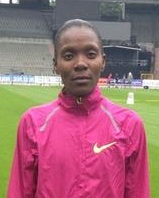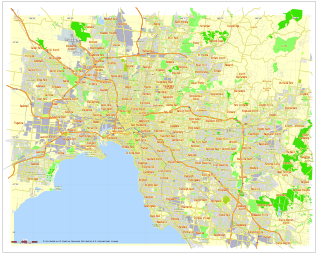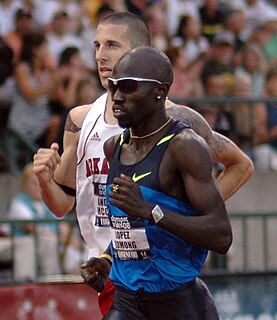
The javelin throw is a track and field event where the javelin, a spear about 2.5 m in length, is thrown. The javelin thrower gains momentum by running within a predetermined area. Javelin throwing is an event of both the men's decathlon and the women's heptathlon.

The long jump is a track and field event in which athletes combine speed, strength and agility in an attempt to leap as far as possible from a take off point. Along with the triple jump, the two events that measure jumping for distance as a group are referred to as the "horizontal jumps". This event has a history in the Ancient Olympic Games and has been a modern Olympic event for men since the first Olympics in 1896 and for women since 1948.

Athletics is a collection of sporting events that involve competitive running, jumping, throwing, and walking. The most common types of athletics competitions are track and field, road running, cross country running, and race walking.

Hurdling is the act of running and jumping over an obstacle at speed. In the early 19th century, hurdlers ran at and jumped over each hurdle, landing on both feet and checking their forward motion. After experimenting with different step patterns the 3-step for high hurdles, 7-step for low hurdles, and 15-step for intermediate hurdles was decided on. In the sport of athletics, hurdling forms the basis of a number track and field events which are a highly specialized form of obstacle racing. In these events, a series of barriers known as hurdles are set at precisely measured heights and distances which each athlete must pass by running over. Failure to pass over, by passing under, or intentionally knocking over hurdles will result in disqualification. Accidental knocking over of hurdles is not cause for disqualification, but the hurdles are weighted to make doing so disadvantageous. Hurdle design improvements were made in 1935, when they developed the L-shaped hurdle. With this shape, the athlete could hit the hurdle and it will tip down, clearing the athlete's path.

Track and field is a sport which includes athletic contests established on the skills of running, jumping, and throwing. The name is derived from where the sport takes place, a running track and a grass field for the throwing and some of the jumping events. Track and field is categorized under the umbrella sport of athletics, which also includes road running, cross country running, and race walking.

The 800 metres, or 800 meters, is a common track running event. It is the shortest common middle-distance running event. The 800 metres is run over two laps of the track and has been an Olympic event since the first games in 1896. During indoor track season the event is usually run on a 200-metre track, therefore requiring four laps.

A bowling ball is a hard, spherical ball used to hit bowling pins in the sport of bowling.

Drake Stadium is a stadium on the campus of Drake University in Des Moines, Iowa, United States. Best known as the home of the Drake Relays, it also serves as the home field of the university's football team. It opened in 1925.

Denean Elizabeth Howard-Hill is an American athlete who competed mainly in the 400 metres.
Dwayne Eugene Evans is an American athlete who mainly competed in the 200 meters.

Hodges Stadium is a multi-purpose stadium at the University of North Florida (UNF), and the home field for the North Florida Ospreys soccer, track and field, and cross country teams. It is located on the university's campus in Jacksonville, Florida, U.S. It is named for George and Kernan Hodges, who donated $2 million to upgrade the facility in 2006.
The men's marathon event was part of the track and field athletics programme at the 1920 Summer Olympics. The distance of this race was 42.75 kilometres. The competition was held on Sunday, 22 August 1920.

John McDonnell Field is the outdoor track facility at the University of Arkansas in Fayetteville, Arkansas, and is home to the Arkansas Razorbacks. The field is named after former head coach John McDonnell, who ended his thirty-six-year collegiate head coaching career as the most successful coach in NCAA track history, attaining a total of 42 NCAA Championships in three different sports with the Razorbacks. Renovated in 2006, it is one of only ten International Association of Athletics Federations Class 1 certified tracks in the United States.
Beynon Sports Surfaces is a manufacturer and installer of synthetic all-weather running tracks. They are part of Tarkett Sports and are based in Hunt Valley, Maryland. Beynon Sports Surfaces manufactures three types of outdoor synthetic athletic tracks; spray coat, sandwich and full pour polyurethane. They also offer surfaces for fieldhouses and gymnasiums.

Betsy Saina is a Kenyan athlete in long distance running.
The track surface of a horse racing track refers to the material of which the track is made. There are three types of track surfaces used in modern horse racing. These are:
Mondotrack is a trademarked synthetic track surface used for Track and field athletics. Mondotrack is developed by Mondo, a world leader in Track and field surfacing. Research was done to achieve the best possible surface for track events that will enhance performance and decrease the chance of injury. All Mondotracks come with a woven top layer and a hexagonal base layer. Unlike other tracks, Mondotracks can be different colors. Mondotracks are very prominent around the world.


























